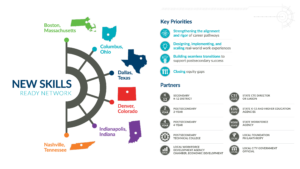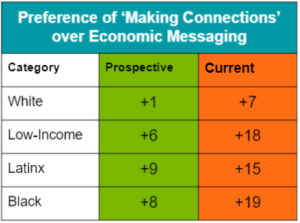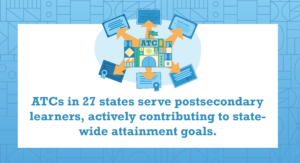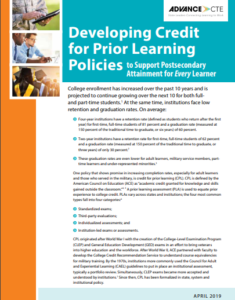 As part of ongoing blog topics aimed at supporting all learners in the realization of the national vision for the future of Career Technical Education (CTE), CTE Without Limits, Dr. Amanda Bastoni, Educational Research Scientist at CAST and Dr. Tunisha Hobson, State Policy Manager engaged in a discussion to highlight the importance of providing support for CTE learner success in rural areas. CAST is a nonprofit education research and development organization, and Dr. Bastoni has conducted multiple research projects on rural learner access and engagement in STEM-focused programs. [Note: this interview has been edited for length and clarity].
As part of ongoing blog topics aimed at supporting all learners in the realization of the national vision for the future of Career Technical Education (CTE), CTE Without Limits, Dr. Amanda Bastoni, Educational Research Scientist at CAST and Dr. Tunisha Hobson, State Policy Manager engaged in a discussion to highlight the importance of providing support for CTE learner success in rural areas. CAST is a nonprofit education research and development organization, and Dr. Bastoni has conducted multiple research projects on rural learner access and engagement in STEM-focused programs. [Note: this interview has been edited for length and clarity].
Considering your wealth of experience in this area, how do you think states should approach learner access to CTE in rural areas?
State leaders should create policies that support small rural employers’ participation in CTE. A quick way for states to support rural learners is through work-based Learning. One example, in New Hampshire (RSA 188 –E: 9-a), employers of any size can be eligible for a tax credit against business profit taxes up to 50 percent for salaries of students and supervisors participating in work-based learning experiences and up to 100 percent for supplies and equipment donated for related use to an educational program offered by the regional CTE center when they make donations of time, money and goods for CTE centers.
Learner access can also begin with large scale remote career day programs and intentional employer engagement in the local and broader communities. There is a rural community in Arizona that is conducting school-wide career days where the whole school engages with different employers in activities and conversations about the experiences of working in that field.
Additionally, I think there is an opportunity to engage employers and industry partners in rural areas by preparing them for filling roles with learners. Many rural employers are willing to support work-based learning experiences, but there is a need to equip them with the right tools for success. Equipping employers with tools describing the work-based learning continuum provides an opportunity for employer engagement from small sized companies to larger corporations in understanding the experiences that can be provided to learners in rural communities.
What are some best practices states can use to support rural learners to access equitable opportunities in CTE?
Equip educators through professional development: Communicating the complexities of rural learner experiences is reliant upon the messenger. The most well meaning practitioner may not understand the challenges rural learners encounter, so it is important to find research based professional development that encourages engagement for rural learners. Ultimately, teachers can leverage their community relationships to connect learners to additional resources and opportunities.
Access CTE Without Borders while considering the digital divide: Using asset-based learning approaches to meet the needs of rural learners is important. State leaders should consider innovative approaches to realizing career pathway experiences. One example, simplistically, consider designing experiences where learners can leverage cell phones rather than laptops or computers they may not have access to. Additionally, consideration for STEM through outdoor recreation related career pathways and experiences invite rural learners to engage in CTE without borders.
Build social capital for underrepresented rural learners, particularly for careers they do not see in their community: Family engagement and inclusion of learner voice is a foundational requirement for decision making and helping learners build their social capital. Policy makers and practitioners are critical to move the work forward, but the voices of learners will drive effective change in communities. Efforts to elevate learner voice can include sharing strategies, analyzing information, and developing solutions can not only help rural learners understand how social networks are being developed but also help build positive self-identity.
Encourage and support virtual work-based learning experiences within the classroom: Embedding virtual work-based learning experiences in CTE coursework bolsters learner exposure to careers beyond their communities. Examples like BioFab Explorer from CAST, which aims to broaden the participation of underrepresented populations in rural communities in biofabrication and biomanufacturing, embeds a components of career guidance curriculum, including work-based learning simulations and activities that teachers can use to help students explore careers and develop and demonstrate industry skills, to dual enrollment opportunities.
What guidance can help states remove barriers with postsecondary program persistence in rural areas?
Rural learners need access to transportation, childcare, and paid work-based learning experiences to support their families and encourage persistence in a career pathway. Offering paid apprenticeships and internships related to outdoor recreation through postsecondary programs are critical in rural areas. According to research, many rural regions are currently experiencing declines in traditional resource-extractive industries such as mining and timber harvesting.
Like many “amenity/decline” regions, New Hampshire was significantly impacted by the loss of paper mills in the 1990s followed by the 2008 recession; however, the region has also seen steady growth in outdoor recreation. In 2020, outdoor recreation represented a higher percentage of New Hampshire’s GDP (2.6 percent) than the U.S. average (1.8 percent), ranking it 11th nationally (U.S. Bureau of Economic Analysis, 2021). Similar rural states across the country are leveraging the outdoors as a significant positive asset for recreation and employment through legislation which creates opportunities in career pathways for learners. In 2021, New Hampshire joined 13 other states including Maine, Vermont, North Carolina, Oregon, Montana, Virginia, and West Virginia, in committing to establish State Offices of Outdoor Recreation Industry Development (Confluence of States, 2018).
Additional Resources
With Learners, Not for Learners: A Toolkit for for Elevating Learner Voice in CTE
CTE on the Frontier: Rural CTE Strategy Guide
Dr. Tunisha Hobson, State Policy Manager
_______________________________________________________________________
About- Dr. Amanda Bastoni
Dr. Bastoni is a former CTE teacher and Director. While currently employed as an Educational Research Scientist at CAST, some of her research projects have included:
- Inclusion, Access, Equity and Diversity (IAED) National coordinator for ACTE
- Principal Investigator on new National Science Foundation (NSF) iTEST Grant working with rural CTE teachers to investigate if drones can be used to increase access to STEM careers for middle school girls and rural learners.
- Principal Investigator on an NSF AISL feasibility Grant focused on understanding how asset-based approaches can be leveraged to increase rural learners’ engagement in STEM-based careers





 These findings have important implications for how CTE can close equity gaps, as well as what aspects of CTE should be elevated when conducting outreach to historically marginalized populations. Communications should be specific about the equitable opportunities provided through CTE to prepare for and jumpstart postsecondary education, as well as to gain visibility and networks through connections and hands-on experiences with like-minded educators, peers and employers .
These findings have important implications for how CTE can close equity gaps, as well as what aspects of CTE should be elevated when conducting outreach to historically marginalized populations. Communications should be specific about the equitable opportunities provided through CTE to prepare for and jumpstart postsecondary education, as well as to gain visibility and networks through connections and hands-on experiences with like-minded educators, peers and employers .  Advance CTE’s recent report on area technical centers (ATCs),
Advance CTE’s recent report on area technical centers (ATCs),  College enrollment has increased over the past 10 years and is projected to continue growing over the next 10 for both full- and part-time students. At the same time, institutions face low retention and graduation rates. One policy that shows promise in increasing completion rates, especially for adult learners and those who served in the military, is credit for prior learning (CPL). CPL practices have been found increase access to and the affordability of postsecondary opportunities for a variety of learners — particularly adults and members of the military.
College enrollment has increased over the past 10 years and is projected to continue growing over the next 10 for both full- and part-time students. At the same time, institutions face low retention and graduation rates. One policy that shows promise in increasing completion rates, especially for adult learners and those who served in the military, is credit for prior learning (CPL). CPL practices have been found increase access to and the affordability of postsecondary opportunities for a variety of learners — particularly adults and members of the military.  The Georgetown Center on Education and the Workforce (CEW) recently
The Georgetown Center on Education and the Workforce (CEW) recently  The demand for Bachelor’s degrees may be
The demand for Bachelor’s degrees may be  In Vermont, Governor Phil Scott announced the launch of a new initiative called
In Vermont, Governor Phil Scott announced the launch of a new initiative called